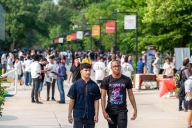You have /5 articles left.
Sign up for a free account or log in.

The Strada Education Foundation and Burning Glass Institute released a new report on postcollege underemployment outcomes.
PeopleImages/iStock/Getty Images Plus
More than half of recent four-year college graduates, 52 percent, are underemployed a year after they graduate, according to a new report from Strada Institute for the Future of Work and the Burning Glass Institute. A decade after graduation, 45 percent of them still don’t hold a job that requires a four-year degree.
Those stark data points were highlighted in a report released today called “Talent Disrupted.” The report outlines employment outcomes for recent bachelor’s degree earners and explores the factors that contribute to their short- and long-term underemployment. It drew on federal data sources, job ads and online résumé and career profiles for more than 60 million workers.
The report defines underemployment as holding a job that doesn’t require a bachelor’s degree, signified by at least half of employees in that role not having one.
“Colleges and universities, states and our country can do more and should do more to help students prepare for the critical transition from college to the labor market,” Stephen Moret, president and CEO of the Strada Education Foundation, said at a media briefing Tuesday.
The report found that graduates who started their careers at a below-college-level job typically stayed underemployed for years afterward. The majority of graduates, 73 percent, who were underemployed in their first jobs remained so a decade after they graduated.
In contrast, 79 percent of graduates who started off in a college-level job continued to hold jobs at that level five years after graduating. And of the graduates who held college-level jobs five years after graduating, 86 percent had college-level jobs a decade out.
Moret said that first jobs are extremely “high stakes” because the outcomes are so “sticky.”
“To me, the single most important takeaway for both individuals and colleges is that for most college graduates, their first postcollege job plays a pivotal role in setting the trajectory of their entire career,” he said.
Black graduates were the most likely to be underemployed compared to their peers, the report found. One year after graduating, 60 percent of Black graduates were underemployed compared to 53 percent of white graduates, 57 percent of Hispanic and Latino graduates, and 47 percent of Asian graduates. The shares of graduates who were underemployed five years down the line fell across racial groups, but which groups had higher rates of underemployment remained relatively consistent.
The kinds of institutions students attended appeared related to their likelihood of being underemployed. Graduates of more selective institutions that served fewer low-income students were more likely to have college-level jobs. Private nonprofit universities had lower shares of underemployed graduates than public universities, 49 percent and 54 percent respectively, a year after graduation; for-profits had the highest share of underemployment—63 percent a year out of college and 58 percent 10 years later. Graduates of historically Black colleges and universities were 15 percent less likely to be underemployed, and graduates from Hispanic-serving institutions were 3 percent less likely to be underemployed, compared to graduates of other institutions.
Underemployment comes at a cost, the report noted. Recent graduates with college-level jobs earn $60,000 annually on average, 88 percent more than the average high school graduate and 50 percent more than underemployed recent four-year graduates.
Preventing Underemployment
The report also highlights factors that appear to make a difference in whether graduates start off in and continue to hold a college-level job.
Internships seemed to give students a leg up. According to the report, the likelihood of becoming underemployed dropped about 49 percent for students who participated in an internship during college. Internships seemed to especially benefit Black graduates of selective private universities—underemployment rates were 17 percentage points lower for these graduates when they had an internship compared to those who didn’t. However, the benefits of an internship in general varied by major.
The report also found that field of study played a significant role in how likely graduates were to hold college-level jobs, more so than what kinds of universities they attended. For example, health, education and engineering majors at less selective public colleges and universities were underemployed at lower rates than biology, psychology and communications majors at selective public institutions.
In general, graduates in STEM fields, such as computer science and engineering, had lower rates of underemployment, though biology and physics graduates didn’t necessarily fare as well. For example, 74 percent of engineering graduates had college-level jobs five years after graduation, compared to 53 percent of biology majors. Math-intensive business fields such as accounting and finance also had better college-level employment outcomes than standard business degrees.
The report offers a series of recommendations for colleges and universities and policymakers to curb underemployment, including ensuring at least one paid internship opportunity for all students, providing transparent employment outcomes data for individual institutions and degree programs, offering comprehensive career coaching to students and ensuring all students have access to fields that contribute to well-paying, college-level jobs.
Moret noted that “the vast majority of students, even if supplied very complete information about their earnings outcomes, are going to choose a field of study that they like and in which they think they would be successful academically”—and they shouldn’t have to change their minds.
“But as we look at the labor market more broadly, it turns out that in many cases, there’s actually more student demand than there is capacity in these high-wage, high-demand programs,” he said. “It’s often less a question of convincing someone to study something different and actually simply making sure that they have access to study the very thing that they want to study.”
The Value of Higher Ed
Matt Sigelman, president of the Burning Glass Institute, noted at the briefing that examining postcollege underemployment data is one “unambiguous” way to look at higher ed’s returns amid a “growing chorus of voices seeking to demand that higher education justify its value.” He noted that other metrics, such as earnings data, can be skewed by graduates going into fields they may love but that don’t pay well.
The question is, are underemployment rates damning for higher ed in that national conversation or are there other nuances at play?
Jaison Abel, head of urban and regional studies at the Federal Reserve Bank of New York, said it’s “very tricky” to interpret underemployment rates in general because a certain amount of underemployment is normal.
“We’ve looked at this over many decades,” he said. “And it’s never the case that nobody is underemployed. What we find is that roughly a third of all college graduates at all points in the business cycle are underemployed. And for recent college graduates, which we define as … the first five years out of school, it’s always higher than that,” about 43 percent, with the exception of the technology boom in the late ’90s.
“I think nobody is going to disagree that a lower underemployment rate is better than a higher underemployment rate,” he noted. But “what should the underemployment rate be? That’s not really clear.”
Rich Deitz, economic research adviser for urban and regional studies at the New York Fed, added that higher education still has financial benefits for graduates who go into below-college-level jobs.
“Even people who are underemployed, if you have a college degree, you’re probably doing way better … than somebody who doesn’t have a college degree,” he said. “It’s not as if there’s no benefit,” especially when underemployment “might be temporary.”
Some higher ed leaders emphasized that while some of the report findings worry them, college has more to offer than college-level jobs.
Lynn Pasquerella, president of the American Association of Colleges and Universities, said the report’s findings are “certainly something we need to pay attention to, especially given the fact that higher education is under siege and people are more skeptical about the value of a college degree than they ever have been.”
But she emphasized that the worry shouldn’t just be whether graduates are in jobs below their education levels that pay less than they could be making but whether they’re in jobs that offer a “sense of meaning and purpose.”
“Getting a job is important,” she said. But a deeper goal is graduates “finding meaningful work, especially at a time when there are skyrocketing mental health issues among college students and graduates. We need to pay attention to helping students find not only a job where they’re not underemployed but work that’s going to be fulfilling and set them up for a trajectory that will allow them to thrive in life.”
She noted that the report doesn’t go into that aspect of the value of higher education.
“We need to get back to the both the public and personal purposes of higher education: educating for democracy, but also lifelong learning, adaptability and flexibility,” which are also valued by employers, she said.
Hironao Okahana, assistant vice president and executive director of the Education Futures Lab at the American Council on Education, similarly noted that higher ed has more to offer than employment outcomes, including giving students the broad knowledge provided by a liberal arts education, producing engaged and educated citizens and providing research discoveries.
At the same time, “these are real data points in a solid analysis presenting one aspect of how postsecondary education contributes to the society and also to individual learners, and that’s helping people to prepare for jobs that can put a roof over their head and bring food to their home. It’s really important,” he said.
He said he saw the findings as an opportunity to think about how universities can better re-engage underemployed graduates and continue preparing them for the workforce.
“The results seem to underscore the importance of postbaccalaureate upskilling and reskilling opportunities” as workforce needs change, such as additional certificates, nondegree credentials or work-based learning opportunities, he said. Some colleges and universities may need to work on “re-engagement with these learners to help them continue to be prepared for the high-demand and emerging occupations.”









